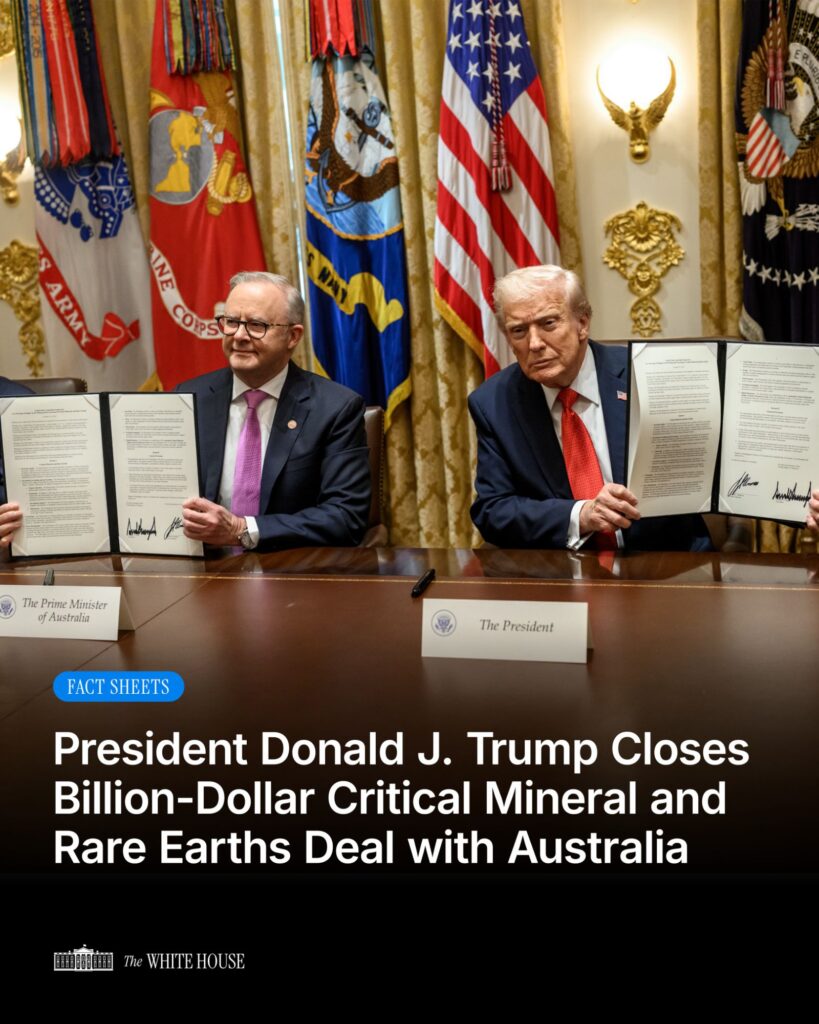WASHINGTON, D.C. Oct 20, 2025 – In a move hailed as a major step toward securing America’s energy independence and fortifying trans-Pacific alliances, President Donald J. Trump and Australian Prime Minister Anthony Albanese signed a groundbreaking Critical Minerals Framework agreement on Monday. The deal, announced from the White House, commits the two nations to over $3 billion in joint investments in critical mineral projects over the next six months, tapping into recoverable resources valued at an estimated $53 billion.
The signing ceremony, held amid a backdrop of American and Australian flags in the East Room, underscores the deepening economic and strategic ties between the U.S. and its longstanding partner Down Under. “This framework achieves critical mineral and energy dominance for the United States while serving as a model for supply-chain cooperation globally,” the White House stated in a fact sheet released alongside the announcement. It positions the pact as a cornerstone of the U.S.-Australia alliance, countering vulnerabilities in global supply chains dominated by adversarial powers.
Unlocking Billions in Investments and Processing Capabilities
At the heart of the agreement is a push to diversify and secure supplies of essential materials like lithium, cobalt, and rare earth elements—vital for everything from electric vehicle batteries to advanced semiconductors and defense technologies. The U.S. Export-Import Bank (EXIM) has issued seven Letters of Interest totaling more than $2.2 billion in financing, poised to unlock up to $5 billion in broader investments for projects enhancing critical minerals extraction and processing.
A flagship initiative includes a U.S. Department of War investment in a state-of-the-art 100 metric ton-per-year advanced gallium refinery in Western Australia. Gallium, a key component in semiconductors and solar panels, has been a choke point in U.S. production; this facility will advance American self-reliance and create high-skilled jobs on both sides of the Pacific.
“This isn’t just about digging up rocks—it’s about building unbreakable supply chains that power American innovation and keep our adversaries guessing,” a senior administration official remarked, emphasizing the deal’s role in reducing dependence on foreign monopolies.
Defense Boost: From Submarines to Drones
The minerals pact is part of a broader package of defense and economic commitments that could reshape regional security dynamics. Australia has agreed to purchase $1.2 billion worth of unmanned underwater vehicles from U.S.-based Anduril Industries, alongside a $2.6 billion deal for Apache attack helicopters. These acquisitions will enhance Australia’s naval and aerial capabilities while injecting capital into American defense firms.
Further solidifying the trilateral AUKUS partnership—joining the U.S., Australia, and the United Kingdom—Canberra pledged an additional $1 billion by year’s end to expand and modernize the U.S. submarine industrial base, following a similar contribution earlier this year. Australia is also investing $2 billion in U.S. companies to develop its Joint Air Battle Management System and integrated air and missile defense systems.
To ensure wartime readiness, the agreement bolsters munitions supply-chain resilience through Australia’s Guided Weapons and Explosive Ordnance (GWEO) enterprise. This will support over 200 U.S. manufacturing suppliers across Texas, Florida, Arkansas, and Alabama, creating ripple effects in Rust Belt and Sun Belt economies.
Economic Wins: Jobs, Trade, and Tech Horizons
Beyond security, the deal promises substantial economic uplift. Australia’s massive superannuation funds—pension vehicles managing trillions—aim to ramp up U.S. investments to $1.44 trillion by 2035, a nearly $1 trillion increase from current levels. This influx is projected to generate tens of thousands of high-paying American jobs in manufacturing, tech, and infrastructure.
Trade barriers are easing too: The pact expands market access for U.S. beef exporters in Australia, opening doors for ranchers in states like Texas and Nebraska to tap into a lucrative new customer base.
Innovation takes center stage with a new framework between NASA and the Australian Space Agency, focusing on civil space and aeronautics. Australian engineers will contribute to developing a lunar rover for NASA’s Artemis program, aiming to return humans to the Moon by 2026. Complementing this, the leaders greenlit a “Technology Prosperity Deal” for collaborative R&D in artificial intelligence, quantum computing, and other frontier technologies—ensuring both nations stay ahead in the global tech race.
A ‘Historic Partnership’ Amid Global Tensions
The agreement arrives at a pivotal moment, as geopolitical frictions in the Indo-Pacific intensify. By aligning resources and expertise, the U.S. and Australia aim to forge a “historic partnership” that not only secures vital natural resources but also promotes shared prosperity and deterrence against expansionist threats.
President Trump, fresh off his 2024 reelection victory, has prioritized such bilateral deals as part of his “America First” agenda, emphasizing fair trade and mutual defense burdens. Prime Minister Albanese, facing domestic pressures over energy costs and housing, touted the pact as a win for Australian workers and exporters.
Reactions on social media were swift and polarized. Supporters praised the move as a “masterstroke” for American manufacturing, while critics in Australia decried it as overly concessional to U.S. interests. Nonetheless, the White House framed the signing as the dawn of a “Golden Age” in U.S.-Australia relations—one built on minerals, missiles, and moonshots.
As implementation ramps up, analysts predict this deal could inspire similar frameworks with other allies, reshaping the global critical minerals landscape for decades to come.

